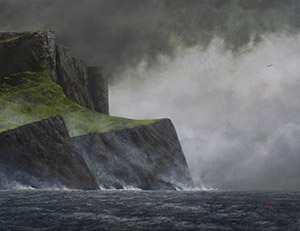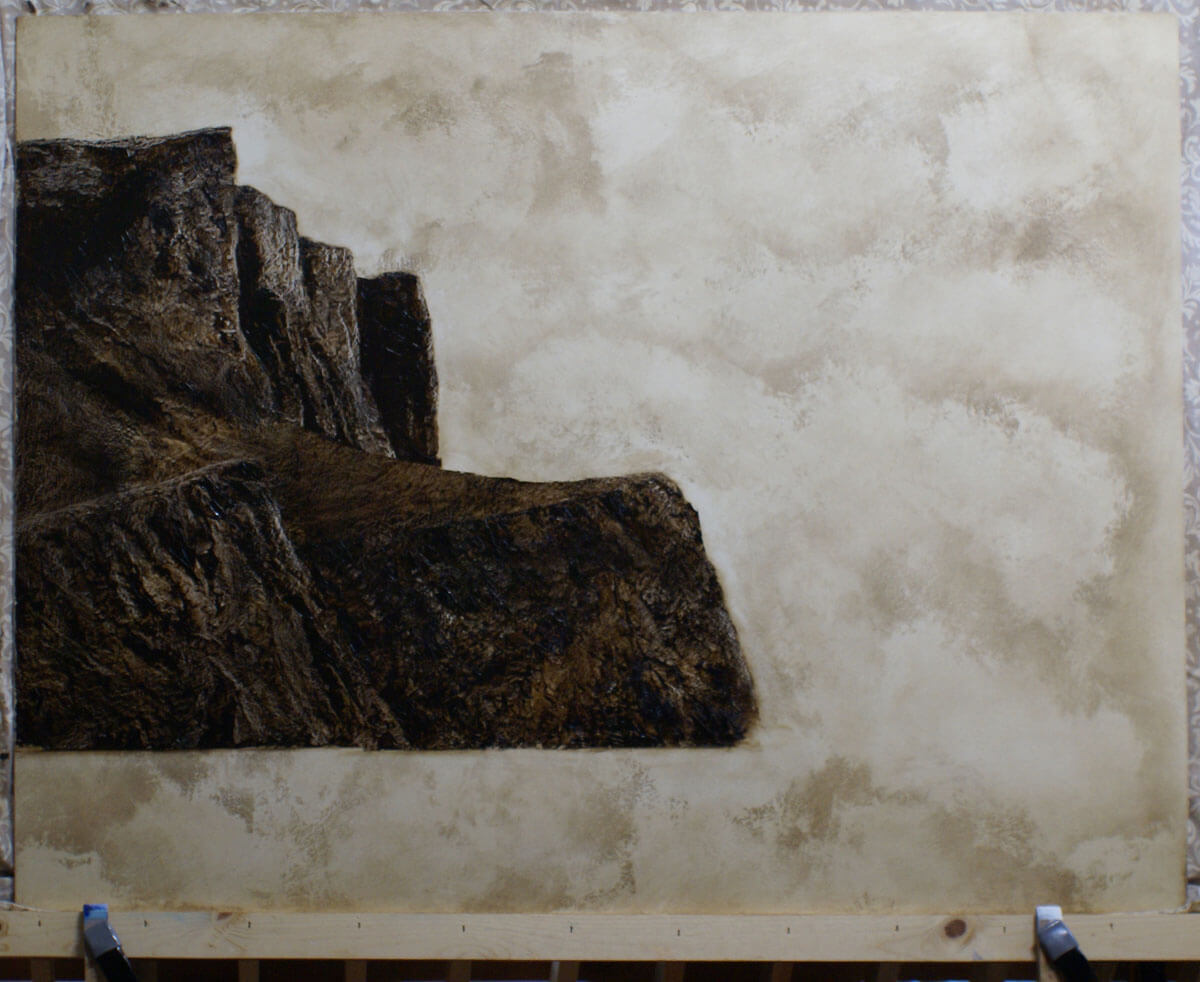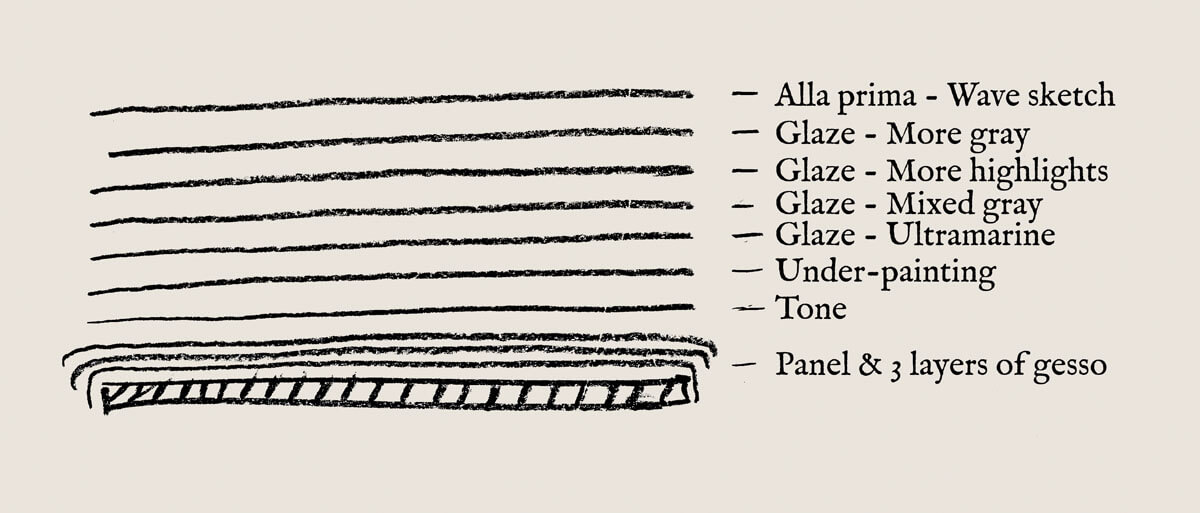You can't just paint over it
By Al R. Young
 |
| Imariva tache Annoide (Lands that Were) by Al R. Young |
This handmade, original oil painting was created by the artist in the studios at Ben Haven.
It is part of The Isles of Rune Project, an ongoing creative endeavor of the Artists of Al Young Studios.
Read more . . .
It is part of The Isles of Rune Project, an ongoing creative endeavor of the Artists of Al Young Studios.
Read more . . .
milestones
Composition finalized — 2017 March
Brushwork begins — 2017 March
Painting completed — 2018 February
Based on regular entries in the project journal for this painting, creation of the artwork involved approximately 32 sessions (from composition and panel preparation to completion of brushwork).
equipment created or modified for this project
None.
dimensions (unframed width x height)
44 in. x 33 1/4 in.
support
Panel
costumes, miniatures, and props created for this project
None.
methodology
In terms of painting or the creative process, generally, stamina is very important. The word is usually applied to physical or mental effort, but I also like to think of what it means in terms of emotion or what comes under the heading of self control.
When I began compositional work for this particular painting, I knew I was taking on a subject unlike any I had ever attempted; not, however, because there was any element in the composition for which I wanted at least some experience. What bothered me from the outset, even after I had worked and reworked the composition, was the rather stark juxtaposition of a very great quantity of rock, a modest area of water, and a large-ish amount of sky, crammed into a relatively small space. Most of all, however, I was apprehensive about the sheer volume of rock. And I enjoy painting rocks!
Sure enough, having knifed-on the cliffs as the very first task completed for the under-painting, I stepped back from the panel (repeatedly) to look at the enormous, floating anvil I was creating. It's at moments like that—moments that can sometimes last for weeks or months, or even years—that the stamina required by the creative process is a matter of patience and forbearance. That kind of stamina is required throughout the creative process; not necessarily constantly, but when the need for it stirs itself to wakefulness and rises on its haunches, it is nothing short of monstrous. Dealing with it is sometimes like working in the silent bulk of a massive shadow emanating impatiently from the sidelines. At other times it stalks sleep, erodes confidence, and steps out from its shadow to contend hand to hand and face to face.
 |
| The floating anvil as it appeared at the end of the first painting session. This under-painting on a gesso-coated panel toned with Raw Umber, was rendered entirely by knife. The technique utilizes the surface texture of the gesso. |
 |
| This is the palette knife used to create the under-painting. Like a chef's knives, painting and palette knives—particularly painting knives—are treasured individuals among an artist's tools. No two are alike, and the techniques an artist discovers through the years become very tightly coupled with each tool. Nor can such a tool easily be replaced—if at all—particularly if its manufacture has been discontinued. |
We also tend to think of waiting as that do-nothing part of life when all the fun stops because we're just w a i t i n g. If waiting actually required that we do nothing, it would be one of the worst things a person could do because to stop doing is to become a sitting duck instead of a duck on the wing, the latter being a great deal more difficult to shoot. Very nearly all of the work done on this painting was done while waiting on the floating anvil to turn into a compositional element that looked at home in its setting.
 |
| This photograph, in the development of the painting, shows the initial layer of the sky. It was taken at the end of the first painting session focused on developing the under-painting of the cliffs. The session involved only an application of Ultramarine Light to deepen the shadows in the underpainting. |
The next step is summarized in this excerpt from my project log for the painting: I thought I was going to apply Quinacridone Violet over the Ultramarine Light that I recently painted in the shadows on the land. I soon discovered that this would have given the shadows and everything else a hue I did not want. Accordingly, I cleaned the Quin off of the panel and embarked upon glazing the walls of the upper cliffs. I mixed Permalba White and Payne's Gray (about 5:1), added medium along the way (i.e., using my brush to lift small amounts from a small stainless dish). In applying the glaze, I tried a knife, a rubber wedge, and a brush. I tried sketching with these, but nothing worked. Then I tried simply applying what was essentially a dry-brush glaze of as thin a layer of the paint as I could create. This worked. I did not want to obscure the sharp edges in the under-painting, nor did I wish to significantly narrow the contrast range in the under-painting . I used the application to suggest shapes in the cliff walls, and rounding them into the dark shadows. Suddenly, the cliffs looked like they belonged to the world containing the clouds already begun on the panel.
As work on the painting progressed, much more was done to the sky and the land, but the sea remained largely untouched because the composition I had envisioned featured fairly high foreground waves crashing against a shore at the viewer's feet. So, having brought the background to a sufficiently developed maturity, it was time to tackle the waves.
 |
| Across a couple of sessions, I sketched the waves and was disturbed by the proximity to the foreground which the waves imposed upon the cliffs. Nor did I wish to treat the cliffs like the bow of a ship. Consequently, without spending any more time on the waves, I decided to remove them. |
 |
| Cross-sectional diagram of painting layers constituting the lower cliffs at the time of the removal of the surf appearing in the foregoing photograph. A diagram of the layers involved in the clouds or the layers constituting the ocean would be different because those regions were developed by their own accumulations of layers. The purpose of this diagram is to illustrate the complexities involved in creating such a painting as well as the complexities that must be addressed whenever it becomes necessary to remove a layer. |
In this particular instance, I was unconcerned about abrasive damage to either the clouds or the ocean because I knew that those areas were much less complete, in their development, than the cliffs, and that alla prima applications would easily obscure tell-tale marks left by sanding (regardless of how fine the grit). So, even though sanding damaged several of the upper layers in the foregoing diagram of the image-structure of the cliffs, I was able to reproduce the cumulative affects of the damaged or removed layers by recreating them, in some cases, and by approximating them in other cases. Doing so involves experience—good and bad— which informs an artist's perceptions, judgments, and ingenuity.
I have elsewhere commented on my need for documentation of each painting project, and the fact that the duration of lapses between painting sessions frequently justifies keeping a project journal. It should be clear, however, from this commentary that another important reason for keeping a log is being able to redo a region whose structural depth involves even a small accumulation of layers. Labels in the foregoing diagram are only titles for what often turns into the mixing of unique colors, their application by myriad techniques (often interwoven in breathtaking complexities), uses of tools in particular ways, etc., etc., which, if not sufficiently documented can very quickly become unreproducible—not so much for a restorer some centuries hence, but for any artist whose memory lacks total recall.
Tags: Lands That Were, 2019, Project commentaries, Tips and techniques
Browse articles by year: 2026 . 2025 . 2024 . 2023 . 2022 . 2021 . 2020 . 2019 . 2018 . 2017 . 2016 . 2015 . 2014 . 2013 . 2012 . 2011 . 2010 . 2009 . 2008 . 2007 . 2006 . 2005 . 2004 . 2003 . 2002 . 2001 . 2000 . 1999 . 1998 . 1997 . 1996
Browse articles by topic: Art lessons . BenHaven Archives . Blank art diaries . Fine art photography . Framing . Illustration . Inspiration and creativity . Isles of Rune . Limited Editions Collection . My Fathers Captivity . News . Novellas . Oil paintings and prints . Operations announcements . Orders and shipping . Overview . Portfolios . The Papers of Seymore Wainscott . Project commentaries . Recipes by Nancy Young . Recommended reading . Recommended viewing . Temple artworks . The Storybook Home Journal . Tips and techniques . Tools supplies and operations
Browse articles by topic: Art lessons . BenHaven Archives . Blank art diaries . Fine art photography . Framing . Illustration . Inspiration and creativity . Isles of Rune . Limited Editions Collection . My Fathers Captivity . News . Novellas . Oil paintings and prints . Operations announcements . Orders and shipping . Overview . Portfolios . The Papers of Seymore Wainscott . Project commentaries . Recipes by Nancy Young . Recommended reading . Recommended viewing . Temple artworks . The Storybook Home Journal . Tips and techniques . Tools supplies and operations